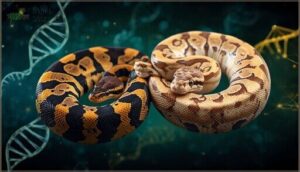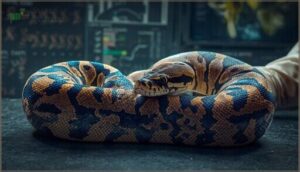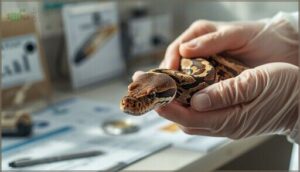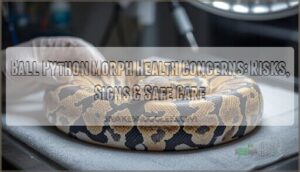This site is supported by our readers. We may earn a commission, at no cost to you, if you purchase through links.
A single breeding decision can condemn a snake to years of involuntary head tremors, poor coordination, and unrelenting stress. This isn’t hypothetical—it’s the documented reality for thousands of ball pythons carrying specific genetic mutations prized solely for their visual appeal.
The explosive growth of the morph market, driven by over 7,000 color and pattern variations, has created a troubling disconnect between what looks striking in a photograph and what allows an animal to thrive. Ethical considerations in ball python genetics extend far beyond preference, encompassing neurological disorders, skeletal defects, conservation pressures, and the fundamental question of whether aesthetic novelty justifies compromised quality of life.
Understanding these genetic realities, from inheritance patterns to welfare outcomes, helps you make informed decisions that prioritize animal health without sacrificing the beauty that makes these snakes appealing.
Table Of Contents
Key Takeaways
- Certain ball python morphs, particularly the spider morph, carry a 100% incidence of neurological disorders like wobble syndrome that cause permanent head tremors, poor coordination, and compromised quality of life—making aesthetic breeding decisions a direct gamble with animal welfare.
- The explosive morph market has produced over 7,000 genetic variations in three decades, but profit-driven overproduction has created severe market saturation with nearly 28,000 ball pythons listed on MorphMarket alone by 2024, overwhelming rescue organizations and exposing gaps in demand management and breeder ethics.
- Wild populations have faced significant pressure from the captive trade, with over 3 million ball pythons exported from West Africa between 1975 and 2020, while captive overbreeding now threatens genetic diversity through repeated inbreeding and genetic homogenization.
- Ethical breeding practices require transparency in genetic testing, disclosure of inherited health risks, and prioritization of animal welfare over aesthetics, yet fewer than 15% of facilities meet comprehensive welfare standards due to voluntary and inconsistent industry regulations.
Ball Python Genetics and Morph Development
Understanding how ball python morphs come to exist requires a working knowledge of the genetics behind them. The breeding industry has catalogued over 7,000 genetic variations in the past three decades, each resulting from specific mutations and inheritance patterns that breeders can predict and manipulate.
Let’s examine how these morphs develop, how genetic traits pass from one generation to the next, and what drives breeders to create new variations.
Overview of Ball Python Morphs
A ball python morph is any color or pattern variation created through genetic mutations, and today’s market showcases remarkable trait diversity. Designer morphs reflect decades of selective breeding focused on aesthetics, yet ethical considerations demand deeper understanding of their genetic basis.
Consider these key classifications:
- Foundational morphs like Albino and Pastel established early breeding programs
- Blue Eyed Leucistic morphs demonstrate complex genetic interactions
- Multi-gene combinations produce novel phenotypes
- Market trends now favor striking yellows and whites
Ball pythons exhibit unparalleled genetic variation within the animal kingdom.
Genetic Mutations and Inheritance Patterns
Understanding snake genetics requires familiarity with three inheritance patterns. Dominant inheritance traits like Pinstripe appear with just one gene copy, while recessive traits such as Piebald demand two copies for visual expression. Co-dominance produces distinct “super” forms when homozygous—Pastel becomes Super Pastel, for instance.
Genetic testing now identifies carriers and confirms mutation examples in melanin genes like TYR and OCA2, enhancing genetic diversity management in your breeding decisions. Many breeders find success with co-dominant ball python morphs due to their predictability.
Creation and Selection of New Morphs
Once you grasp inheritance patterns, creating new ball python morphs involves strategic pairing across multiple generations. Breeders combine known mutations—often targeting color, pattern, and scale texture—to develop over 7,500 distinct morphs.
Genetic testing of shed skins accelerates this process, though multi-gene morphs present significant challenges with lower breeding success rates.
Market demand influences these breeding strategies for morphs, yet morph creation ethics demand you balance novelty with animal welfare considerations.
Health Risks Linked to Genetic Breeding
When you breed for striking patterns and vivid colors, you’re not just manipulating appearance—you’re sometimes gambling with an animal’s health. Certain genetic combinations that produce the most sought-after morphs also carry serious medical consequences, ranging from neurological problems to skeletal deformities.
Breeding for striking patterns and vivid colors often gambles with an animal’s health, carrying serious medical consequences
Understanding these risks is essential if you want to make informed decisions about breeding or purchasing ball pythons.
Neurological Disorders and Wobble Syndrome
You’ve probably seen it happen—a ball python’s head weaving side to side like it’s caught in an invisible current. That’s wobble syndrome, a neurological condition seen in certain designer morphs, especially the spider morph. Clinical studies show 100% of spider morphs exhibit neurological disorders to varying degrees, from mild head tremors to severe mobility issues:
- Side-to-side head tremors and corkscrewing movements
- Poor coordination and reduced striking accuracy
- Impaired righting reflexes when turned upside down
- Symptoms worsening under stress or inadequate care
The genetic mutation creating these stunning patterns also malforms inner ear structures, confirmed through MRI and CT scans. Ethical breeding demands transparency about these genetic predispositions and symptom severity, yet disclosure remains inconsistent across the industry.
Skeletal Abnormalities and Physical Defects
Beyond neurological issues, skeletal abnormalities pose serious ethical considerations in designer morphs. Spinal kinks occur with increased frequency when breeding certain visual morphs head-to-head, particularly caramel albinos and other genetic predispositions.
These physical deformities range from subtle vertebral irregularities to severe malformations causing respiratory failure at birth. CT scans reveal distinct structural differences in affected animals, confirming that morph-linked defects result from breeding consequences targeting aesthetic traits over health.
Inbreeding, Reduced Fertility, and Immune Issues
While inbreeding effects may remain hidden initially, they accumulate across generations, weakening genetic diversity and compromising long-term health. Reduced fertility surfaces as decreased hatch rates and egg-passing difficulties, while immune suppression manifests through heightened susceptibility to chronic infections.
These genetic health concerns emphasize critical ethical considerations: prioritizing sound breeding strategies over aesthetic appeal protects ball python welfare and maintains population resilience against disease pressures.
Animal Welfare in Morph Breeding
Animal welfare in morph breeding isn’t just about avoiding obvious deformities—it’s about recognizing that every breeding decision affects the snake’s quality of life. When you prioritize appearance over function, you risk creating animals that suffer in ways that aren’t immediately visible.
The following considerations highlight where aesthetics and well-being often clash, and what responsible breeding should look like.
Balancing Aesthetic Traits and Well-being
When you prioritize color over health in morph selection, you’re making a choice with real consequences. The spider morph’s wobble syndrome, for instance, causes head tremors and poor coordination that can’t be ignored.
Ethical breeding standards demand that you avoid morphs producing suffering, while consumer awareness drives healthier genetic traits. Breeding standards must balance aesthetic appeal with animal welfare, ensuring genetic diversity and addressing legitimate health concerns through transparent genetic ethics.
Environmental Enrichment and Psychological Health
Your ball python’s psychological wellbeing depends on environmental enrichment that goes far beyond a simple enclosure. Studies show enriched snakes exhibit 45% greater activity levels and 50% fewer stress behaviors.
Behavioral enrichment through cognitive tasks, varied substrates, and sensory stimulation provides essential stress reduction while promoting cognitive health.
Without proper environmental stimulation, you’ll see lethargy, repetitive behaviors, and compromised welfare standards that undermine responsible animal husbandry practices.
Responsible Breeding Versus Profit-driven Practices
Responsible breeding practices and profit-driven approaches stand at opposite ends of the spectrum. Ethical ball python breeders prioritize genetic diversity, maintain animal welfare standards, and use genetic testing to screen for harmful traits before breeding.
In contrast, profit-driven operations often overlook breeding ethics, producing high volumes without considering market regulation or sustainable practices, which directly compromises the health of these animals.
The Ethics of Designer Ball Python Morphs
Designer morphs sit at the crossroads of science, commerce, and conscience, and that’s where things get uncomfortable. You’re buying more than a snake when you choose a high-end morph—you’re casting a vote for what the industry will produce next.
Let’s break down the core ethical tensions that define this debate, from breeding controversies to the risks buyers often don’t see coming.
Controversies in Selective Breeding
Selective breeding for designer ball python morphs has sparked fierce debate in the reptile community. When you prioritize aesthetics over genetic ethics, you risk producing animals with serious health concerns. Spider morphs, for instance, commonly suffer wobble syndrome—a neurological disorder that led the International Herpetological Society and REPTA to ban their sale.
These breeding regulation efforts reflect growing awareness that animal rights and responsible breeding must guide morph standards, not market trends alone.
Consumer Demand and The Rise of Unhealthy Morphs
Consumer demand drives unhealthy breeding practices in ways you mightn’t expect. Social media influencers and celebrity endorsements can inflate prices for morphs like the spider—selling for hundreds to thousands of dollars—despite wobble syndrome affecting motor function.
When you’re drawn to rare colorations or unique patterns, market saturation from overbreeding follows, producing surplus animals with genetic health problems that often end up surrendered or requiring specialized veterinary care.
Transparency and Disclosure of Genetic Risks
The demand for designer morphs makes breeder disclosure laws more critical than ever. Despite industry transparency trends and advocacy group influence, most sellers don’t provide genetic testing results or health guarantees. You deserve access to genetic health information before purchase. Ethical considerations require transparency about:
- DNA test results identifying harmful genes
- Neurological screening outcomes for wobble syndrome
- Undisclosed risk impact on lifespan and quality of life
- Previous health complications in breeding lines
- Genetic testing access for verification purposes
Conservation, Sourcing, and Overproduction
The captive breeding industry doesn’t exist in a vacuum, and its effects ripple far beyond individual snakes in racks and tubs. Wild populations face pressure from collection and habitat loss, while the captive market has become oversaturated to a degree that raises serious questions about animal welfare.
You need to understand how sourcing decisions, overproduction, and conservation intersect if you want to participate ethically in this hobby.
Impact of Captive Breeding on Wild Populations
Although captive breeding reduces wild sourcing, over three million ball pythons were exported from West Africa between 1975 and 2020, altering wild populations through genetic homogenization and disease transmission. Reintroduction effects from ranching programs complicate conservation efforts, as released individuals often carry non-native genetics.
Export regulation remains insufficient, and habitat loss continues threatening these populations despite reduced wild-caught imports in recent years.
Overproduction and Market Saturation
While wild-caught imports have declined, captive overproduction now poses serious welfare concerns. By April 2024, nearly 28,000 ball pythons saturated MorphMarket alone, with supply outpacing demand by roughly 40%.
This market saturation drives price volatility, forces breeders to dump unsellable animals, and undermines genetic diversity through repeated inbreeding.
Rescue organizations are overwhelmed as surplus snakes flood the market annually, revealing fundamental gaps in demand management and breeder ethics throughout the supply chain.
Ethical Sourcing and Avoiding Wild-caught Imports
When you’re choosing a ball python, ethical sourcing matters more than you might think. Since 1975, over 3 million wild-caught individuals have been exported from West Africa, with ranching practices leaving survival rates uncertain and ecological impacts poorly documented.
Prioritizing captive-bred alternatives protects wild populations while supporting these critical ethical considerations:
- Wild-caught impacts: 75% of Togolese hunters report declining wild encounters
- Import regulations: CITES permits remain inconsistently enforced across exporters
- Captive alternatives: Captive-bred snakes adapt better and reduce conservation implications
- Consumer responsibility: Your purchasing choices directly influence ethical trade practices
Promoting Ethical Practices in Breeding
Changing the landscape of ball python breeding requires both individual accountability and industry-wide reform. You can’t overhaul an entire market overnight, but you can make informed choices that push breeders toward higher standards of care and transparency.
The following sections outline practical steps for recognizing ethical practices, understanding your role as a consumer, and supporting the future direction of responsible ball python genetics.
Recognizing Ethical Breeders and Industry Standards
You deserve a breeder who prioritizes animal health over profit margins, yet fewer than 15% of facilities meet all welfare standards. Look for genetic disclosure about inherited risks, enriched housing rather than bare racks, and published health records for each animal.
Industry standards remain voluntary and inconsistent, with no mandatory accreditation systems enforcing ethical considerations, making your informed scrutiny essential for responsible breeding practices.
The Role of Education and Consumer Responsibility
Understanding ball python genetics informs your ethical consumer choices when purchasing morphs. Breeder transparency about inherited health risks reduces harmful demand by up to 25%, while consumer responsibility drives responsible morph purchasing patterns that prioritize animal welfare.
When you demand genetic disclosures and health screenings, breeders respond by reducing health issues through better testing, ultimately shifting the industry toward responsible ownership and public awareness.
Future Directions for Ethical Ball Python Genetics
The ball python genetics industry stands at a crossroads, and your choices will shape its trajectory. Genetic identity tests and data-driven decisions promise unmatched precision, but technology alone won’t guarantee welfare-centered breeding without your engagement.
Leading-edge approaches demand:
- Sustainable breeding models that prioritize genetic diversity over short-term profit margins
- Community engagement through transparent data sharing and collaborative health tracking
- Regulatory frameworks supporting ethical considerations in morph development
Responsible breeding evolves when genetic testing benefits animal welfare, not just marketplace aesthetics. Your informed participation drives this transformation.
Frequently Asked Questions (FAQs)
Can ball pythons thrive on vegetarian diets?
Ever wonder if your snake could go vegan? Ball pythons are obligate carnivores, requiring whole prey to meet dietary needs and avoid nutritional deficiencies, metabolic impact, and serious health risks from ethical feeding missteps.
How long do ball pythons typically live?
Your ball python can live 20-30 years in captivity with proper care, compared to just 10 years in the wild.
Genetic health, husbandry quality, and morph-related health concerns directly influence their lifespan and overall wellbeing.
What tank size suits adult ball pythons?
Some keepers treat enclosures like studio apartments—cramped and compromising.
Your adult ball python needs minimum dimensions of 4′ x 2′ x 2′ (approximately 75 gallons) to meet husbandry standards and support proper health impacts.
Are ball pythons safe around young children?
Ball pythons rarely bite and pose minimal risk to children when handled properly. Their docile nature makes them suitable for families committed to animal welfare and care.
Supervision guidelines help to assure safe interaction, teaching responsible ownership while offering emotional benefits.
Do ball pythons recognize their owners over time?
Despite anecdotal claims, ball pythons don’t recognize their owners. Research shows they lack cognitive abilities for individual human recognition.
Behavioral adaptation to handling reflects reduced stress, not social bonds with specific keepers.
Conclusion
Every breeding decision casts a long shadow—one that follows an animal through its entire life. The ethical considerations in ball python genetics demand more than surface-level awareness; they require you to weigh beauty against biology, profit against responsibility.
By prioritizing health over hype, supporting transparent breeders, and refusing to normalize suffering for aesthetics, you shift the market toward compassion. Your choices don’t just shape individual lives—they reshape what’s acceptable in reptile culture.
- https://www.newyorker.com/magazine/2024/02/26/inside-the-world-of-designer-ball-pythons
- https://pmc.ncbi.nlm.nih.gov/articles/PMC9377635/
- https://community.morphmarket.com/t/spider-bp-research/17805
- https://www.worldanimalprotection.us/siteassets/reports-programmatic/suffering-in-silence-report.pdf
- https://www.merckvetmanual.com/exotic-and-laboratory-animals/reptiles/viral-diseases-of-reptiles















